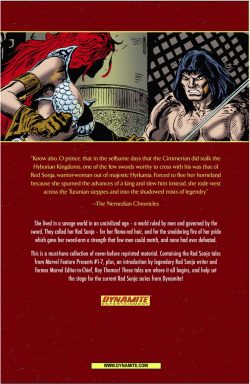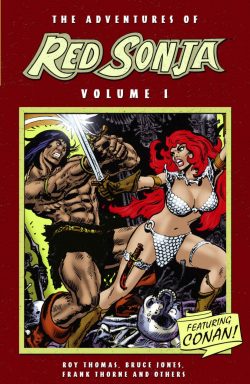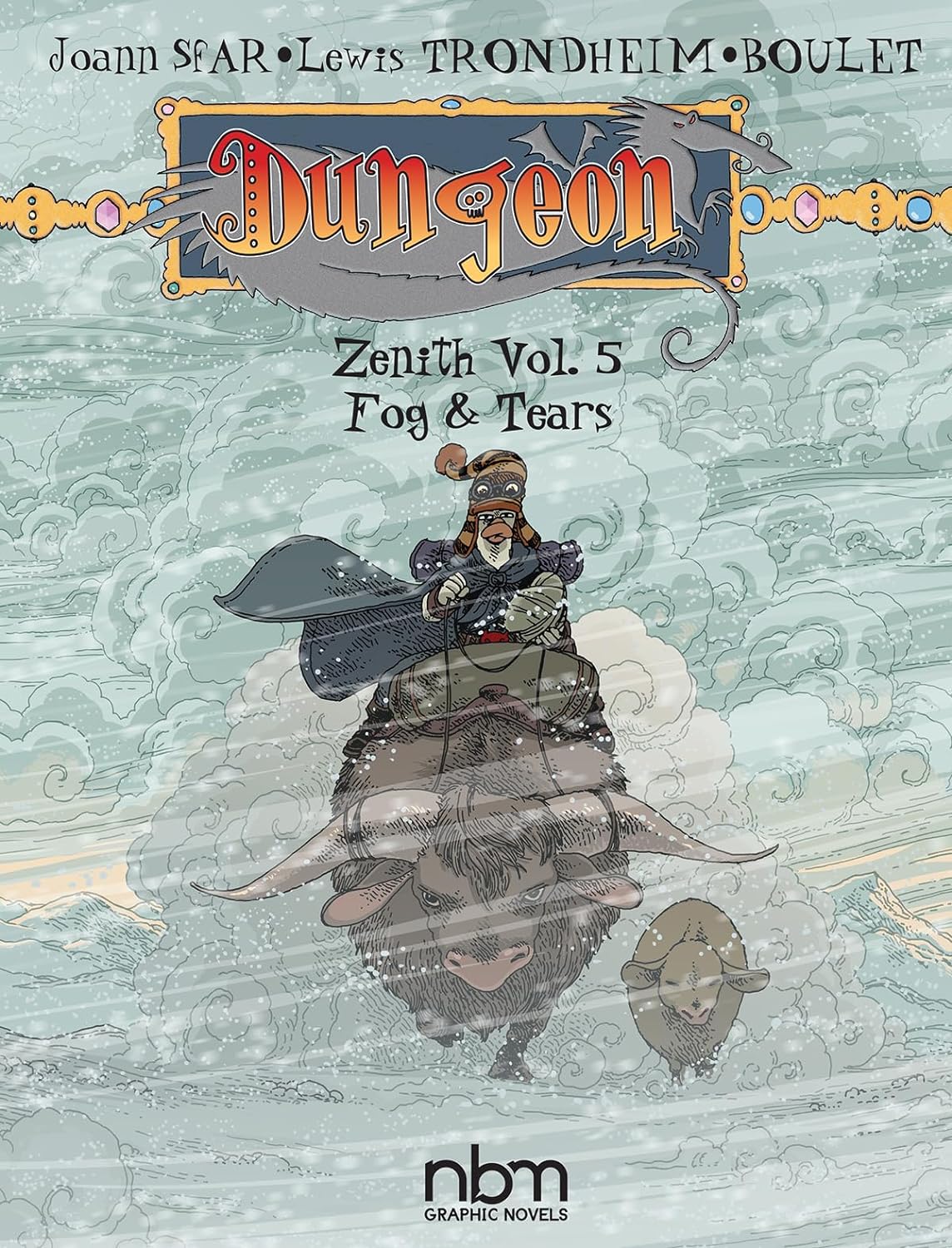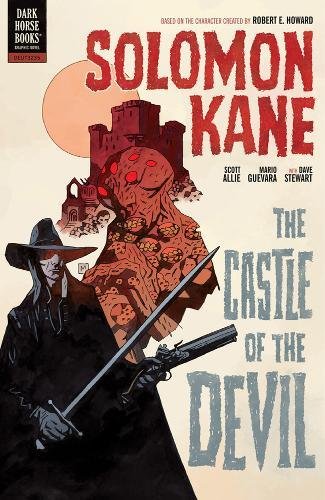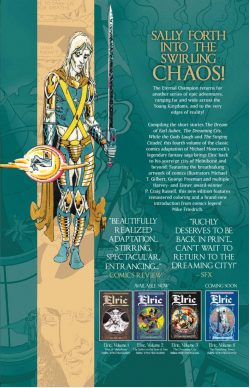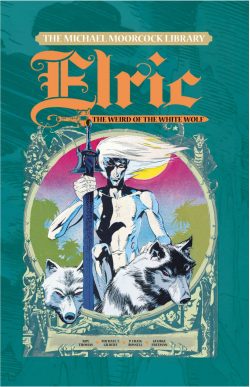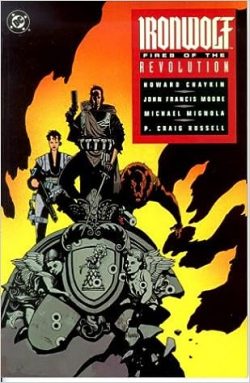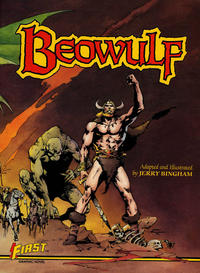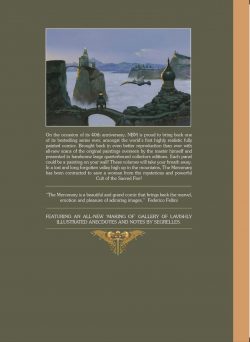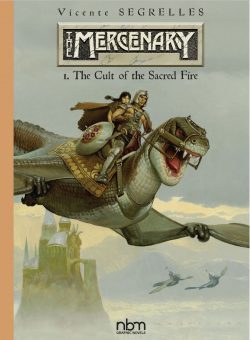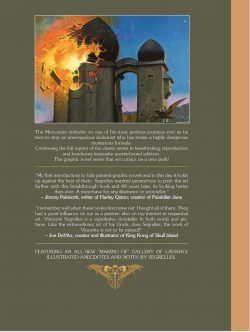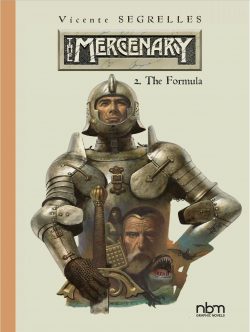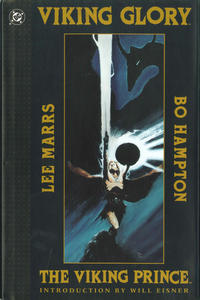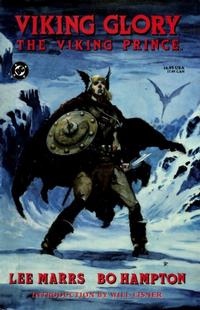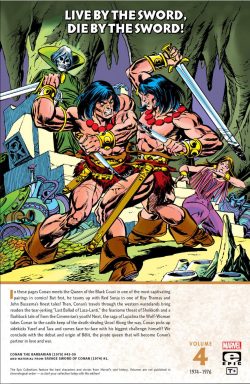
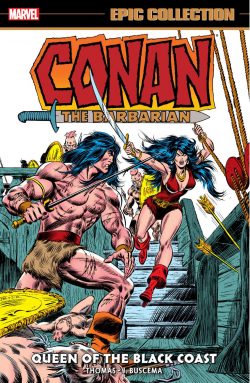
By Roy Thomas, Fred Blosser, John Buscema, Mike Ploog, Tim Conrad & various (MARVEL)
ISBN: 1-84576-137-5 (TPB/Digital edition)
In the 1970’s, America’s comic book industry opened up after more than 15 years of calcified publishing practises promulgated by the censorious, self-inflicted Comics Code Authority: a self-imposed oversight organisation created to police product after the industry suffered its very own McCarthy-style 1950s Witch-hunt. The first genre revisited during the literary liberation was Horror/Mystery, and from those changes sprang migrated pulp star Conan.
Sword & Sorcery stories had been undergoing a prose revival in the paperback marketplace since the release of softcover editions of Lord of the Rings in 1954 and, in the 1960s, revivals of the fantasies of Edgar Rice Burroughs, Otis Adelbert Kline, Fritz Lieber and others were making huge inroads into buying patterns across the world. The old masters had also been augmented by many modern writers. Michael Moorcock, Lin Carter and others kick-started their prose careers with contemporary versions of man against mage against monsters. The undisputed overlord of the genre was Robert E. Howard with his 1930s pulp masterpiece Conan of Cimmeria.
Gold Key had notionally opened the field in 1964 with cult hit Mighty Samson, followed by ‘Clawfang the Barbarian’ in Thrill-O-Rama #2 in 1966. Both steely warriors dwelt in post-apocalyptic techno-wildernesses, but in 1969 DC dabbled with previously code-proscribed mysticism as Nightmaster in Showcase #82 -84, following the example of CCA-exempt Warren anthologies Creepy, Eerie and Vampirella. Marvel tested the waters with barbarian villain/Conan prototype Arkon the Magnificent in Avengers #76 (April 1970) and the same month went all-out with short supernatural thriller ‘The Sword and the Sorcerers’ in their own watered-down horror anthology Chamber of Darkness #4.
Written by Roy Thomas and drawn by fresh-faced Barry Smith (a recent Marvel find who was just breaking out of the company’s still-prevalent Kirby house-style) the tale introduced Starr the Slayer who also bore no small resemblance to the Barbarian-in-waiting…
Conan the Barbarian debuted with an October 1970 cover-date and – despite early teething problems, including being cancelled and reinstated in the same month – these strip adventures of Howard’s primal hero were as big a success as the prose yarns they adapted. Conan became a huge hit: a blockbuster brand that prompted new prose tales, movies, TV series, cartoon shows, a newspaper strip and all the other paraphernalia of global superstardom.
However, times changed, sales declined and in 2003 the property found a different comics publisher, before – after decades away – in 2019 the brawny brute returned to the aegis of Marvel.
Their first bite of the cherry was retroactively subtitled “the Original Marvel Years” due to the character’s sojourn with Dark Horse Comics and other intellectual rights holders with this fourth compendium – spanning cover-dates August 1974 to February 1976 – reprinting Conan the Barbarian #43-59 plus a tale from Savage Sword of Conan #1. It highlights a period when the burly brute was very much the darling of the Comics universe and when artist John Buscema made the hero his very own.
Adaptor Thomas had resolved to follow the character’s narrative timeline as laid out by Howard and successors such as L. Sprague de Camp and Lin Carter, expanded and padded out with other adaptions of REH and his contemporaries and – almost as a last resort – all-new adventures. Thus, content was evermore redolent of pulp-oriented episodic action rather than traditional fantasy fiction.
As we hurtle back in time approximately 12,000 years to a forgotten age of wonders, and – following the now traditional map of ‘The Hyborean Age of Conan’ plus accompanying mandatory establishing quote, the saga resumes with a riotous romp from Savage Sword of Conan #1 (August 1974).
The series had broken many moulds, including being able to sustain not just a general audience but also appropriate for Marvel’s monochrome magazine division, offering more explicitly violent and risqué fare for supposedly more mature readers. For this market he debuted in Savage Tales #1 (1971) before winning his own magazine residency. Savage Sword of Conan launched in August 1974, running 235 issues until its cancellation in July 1995. Throughout its life SSoC offered powerful stories, features on all things RE Howard and some of the most incredible artwork ever to grace comics pages. The antediluvian experience opens with #1’s lead yarn. Thomas, John Buscema & Pablo Marcos’ ‘Curse of the Undead-Man’ was adapted from Howard’s short story Mistress of Death with Conan meeting old comrade Red Sonja amongst the fleshpots of “The Maul” in Zamora’s City of Thieves before falling foul of sorcerer Costranno: a mage for whom being chopped to mincemeat is only a minor inconvenience but who still strenuously objected to being robbed and murdered…
A sequence of self-contained tales resumes in the colour newsstand Conan the Barbarian #43 (October 1974) as Thomas continues to follow Howard and de Camp’s roadmap. The saga begins with the warriors’ rapid escape from Zamora, relentlessly pursued by bounty hunters. Trouble finds them when they are taken by bat-monsters to a ‘Tower of Blood’ (inked by Erni Chan nee Chua) where the husky lout is forcibly “admired” by ancient queen-with-a-secret Uathacht and threatened by her sorcerer brother Morophla. The mage has been hiding from Conan’s sworn foe Thoth Amon for simply ages and has revolting plans for both warriors which go appallingly awry in #44’s ‘Of Flame and the Fiend!’ (collaboratively inked by “The Crusty Bunkers”). Exposed as less than human the siblings inflict a ghastly burden on Conan but aren’t sage enough to escape his and Sonja’s inevitable vengeance…
An eerily memorable change-of-pace tragedy sees the shaken and morbidly morose barbarian befriend a foredoomed bard in ‘The Last Ballad of Laza-Lanti’: agreeing to take the troubled troubadour to his place of origin and encountering yet again the horrors that lurk in the Hyborian age…
The next half year comprises a protracted and loving adaptation of prose pulp yarn Kothar and the Conjurer’s Curse, originally penned by the prolific and justifiably legendary Gardner F. Fox (if anybody deserves the title of Elder God of comic books it must be He!). Here our cantankerous Cimmerian is once again embroiled in war between wizards and wades through imperilled maidens and gore galore in equal amounts, beginning with ‘The Curse of the Conjurer!’ as inked by Joe Sinnott. When the wanderer is coerced by magician Merdoramon into delivering a protective amulet to embattled Regent Themas Herklar of Phalkar, the simple mission to safeguard the ruler from his own treacherous court wizards soon proves riddled with undisclosed peril and duplicity.
En route he saves supposed witch Stefanya from burning at the stake and is diverted by her need to have him rescue her master Zoqquanor. Although a “good wizard”, the mage had linked her life force to his own and she needs to ensure his future safety. That proves tricky when they pull the comatose conjuror from his shattered castle and awaken crystal homunculus Shokkoth, and gets even harder in the Dan Adkins inked ‘Goblins in the Moonlight!’ (#47) as a R&R stopover in seemingly sedate ruins sparks an attack by more supernatural horrors…
The issue also provided a text feature on ‘Conan’s Parents’ illustrated by Tim Conrad, before the quest resumes in #48 where ‘The Rats Dance at Ravengard!’ Dick Giordano & Adkins inks) as a formative episode from Conan’s youth – with Priestess of the Wild Ursla – leads to a close shave with local warlord Torkal Moh, near death-by-rats and answers to many of the obscure machinations in play, thanks to Ursla’s latterday kinswoman Lupalina the Wolf Mistress…
With the aid of the ‘Wolf-Woman!’ Conan rescues Stefanya – revealed as a crucial pawn in the region’s politics – and topples Torkal Moh, but retrieving the Amulet in #50 unleashes ‘The Dweller in the Pool!’ whose subsequent dispatch by the Cimmerian triggers civil war, the downfall of the Phalkar’s resident magicians and the horror they served and the restoration of a long lost princess in concluding chapter ‘Man Born of Demon!’
Cover-dated July 1975 and stunningly crafted by Thomas, Buscema and Tom Palmer, Conan The Barbarian #52 signalled a turning point in the Cimmerian’s life as he signs on to fight a war with old Corinthian associate Murilo (from Conan #11): now leading a mercenary army of Condottieri dubbed the Crimson Company. He can always use a proven warrior, and also takes under his wing a street urchin/acrobat called Tara of Hanumar whom Conan had saved from an unfair fight…
Re-outfitting the almost-naked wanderer in arms and armour (and clothes!), Murilo’s band are headed to Ronnoco in anticipation of a war between states but the march almost ends in disaster when the mercenaries accidentally awaken an interred horror from antiquity in ‘The Altar and the Scorpion!’ Thanks to Conan the horror from the age of King Kull is defeated, but as the survivors depart they are unaware that a second terror was aroused… and now follows…
Frank Spinger embellished #53 as the Crimson Company reach their client city but are attacked by those inside. When the costly misunderstanding is rectified, Conan has made another enemy after displaying his feelings to arrogant autocrat Prince Vanni who ordered the assault on his comrades and refuses to allow any mercenaries inside walled city of Ronnoco.
King Belzamo is at least more diplomatic as he outlines the causes of the war with rival city-states Carnolla and Pergona and demands his hirelings’ first action: kidnapping the princess Yvonna of Pergona so she can be made to wed Vanni. However, defeating her terrifying bodyguards the ‘Brothers of the Blade!’ proves harder than anticipated and unknown to all, a dark hungry shadow is slowly consuming everything it its path…
Palmer returns in #54 as teen sole survivor Yusef brings a warning of the hungry shadow leading to Conan, Tara and Yusef ordered away to consult ‘The Oracle of Ophir!’ Their reconnaissance and information gathering is hampered by myriad mystic deterrents that culminate in the brawny barbarian battling his own deadly doppelganger and only getting away with highly suspect vague proclamations by guile not force. The party arrives back at Ronnoco (in #55) to find ‘A Shadow on the Land!’ and untold horror besieging the city, prompting Conan to go AWOL and return to the site of a previous victory. His hunch proves correct and he unleashes the one thing the shadow cannot consume, bring an abrupt universally unsatisfactory end to the war – and their pay – through political compromise and economic pragmatism…
Pausing for breath and the Jack Kirby & Joe Sinnott cover for November 1975’s Giant-Size Conan #5 (a reprint vehicle teaming our hero with Michael Moorcock’s doomed king Elric and not included here) Conan, Tara and Yusef quit the Crimson company and in CTB #56 discover ‘The Strange High Tower in the Mist!’ Inked by Pablo Marcos, the tale finds the trio bewildered by a keep apparently populated by oblivious silent ghosts and a bat monster, but seeing in not always believing…
Still sticking to Howard’s roadmap, Thomas and illustrator Mike (Ghost Rider, Man-Thing, Werewolf By Night, Monster of Frankenstein, Weirdworld, Planet of the Apes) Ploog detail an ‘Incident in Argos!’ for #57 that acts as a prelude to a momentous stage in Conan’s life. Falling foul of stupid laws, city guards and sanctimonious judges, the barbarian and his teen charges face jail and punitive amputation until Conan goes wild. Separated, they escape individually just in time for the Cimmerian to reach the long-awaited beginning of Howard’s great love story…
Pulp novelette Queen of the Black Coast was published in the May 1934 Weird Tales, obliquely told of Conan’s time as infamous pirate “Amra”: plundering the coasts of Kush (prehistoric Africa) beside his first great love. The brief but tragic tale of bold buccaneer Bêlit would be expanded over the next few years in an epic storyline that ran to #100 of the monthly comic and officially launched with Conan The Barbarian #58.
Here Thomas, Buscema & Steve Gan launched ‘Queen of the Black Coast!’ as the frantic Cimmerian fugitive finds safe harbour on an outward bound Argossean trading ship caught in a surging tide. Despite barely and extremely publicly escaping a fusillade of guards’ spears, the Northborn outlaw befriends entrepreneurial Captain Tito – himself a regular loser when faced with Argos’ corrupt lawmakers and taxmen – and settles into the mariner’s life.
After visiting many fabulous ports and exotic wild places, Conan’s life changes again when the ship encounters the most feared vessel afloat. When the fighting is done only Conan remains, having made a devil’s feast of the attacking pirates. Even he cannot beat this horde of Kushite warriors but as he prepares to die fighting, the white queen of these black pillagers grants him his life. When some pirates complain, Conan is allowed to earn his place by fighting the objectors and soon settles in… as Bêlit’s prize…
This volume concludes with Thomas, Buscema & Gan’s spellbinding origin yarn as #59 reveals in the words of shaman mentor/guardian N’yaga how the woman remade herself in ‘The Ballad of Bêlit!’. Conan hears how a Shemite child whose seafaring father was king of Asgalun until murdered by Stygians who placed her uncle on the vacant throne. He marvels at her life, growing up among barbarous tribesmen of the Silver Isles where she was trained in warrior arts to best any man. With amazement the Cimmerian learns how, by facing and mastering supernal horrors and using them to destroy a jealous chieftain, the war maiden became – in the eyes of the tribes – the earthly daughter of their Death Goddess Derketa, sworn to take her vengeance on Stygians and all who deal with them…
… And Conan also realises that he loves Bêlit beyond all else, even if she may not be human…
To Be Continued…
With covers by Boris Vallejo, Gil Kane, Dan Adkins, Neal Adams, John Romita, Tom Palmer, Dick Giordano, Jack Kirby, Joe Sinnott, Vince Colletta, this dark love story is also burnished by behind the scenes extras such as a more detailed map of ‘The Hyborean Age of Conan’ and world, taken from 1978’s Conan the Barbarian Marvel Treasury Edition #19 whilst #4 of the same name provides stunningly beautiful front & back covers by Barry Windsor-Smith, and text article ‘An Informal History of the Thomas/Smith Conan’.
There’s also Windsor-Smith’s watercolour Conan image and illustrated page (May) from the 1975 Mighty Marvel Calendar plus House ads, plus original Buscema unused cover art and pencil pages with equivalent inked version from Savage Sword of Conan #1. There are even pre and post CCA moderated images of Bêlit and Conan…
Stirring, evocative, cathartic and thrilling, these yarns are deeply satisfying on a primal level, and this is one of the best volumes in a superb series starring a paragon of adventure heroes. This is classic pulp/comic action in all its unashamed exuberance: an honestly guilty pleasure for old time fans and newbies of all persuasion. What more does any red-blooded, action-starved fan need to know?
© 2021 Conan Properties International, LLC (“CPI”)
